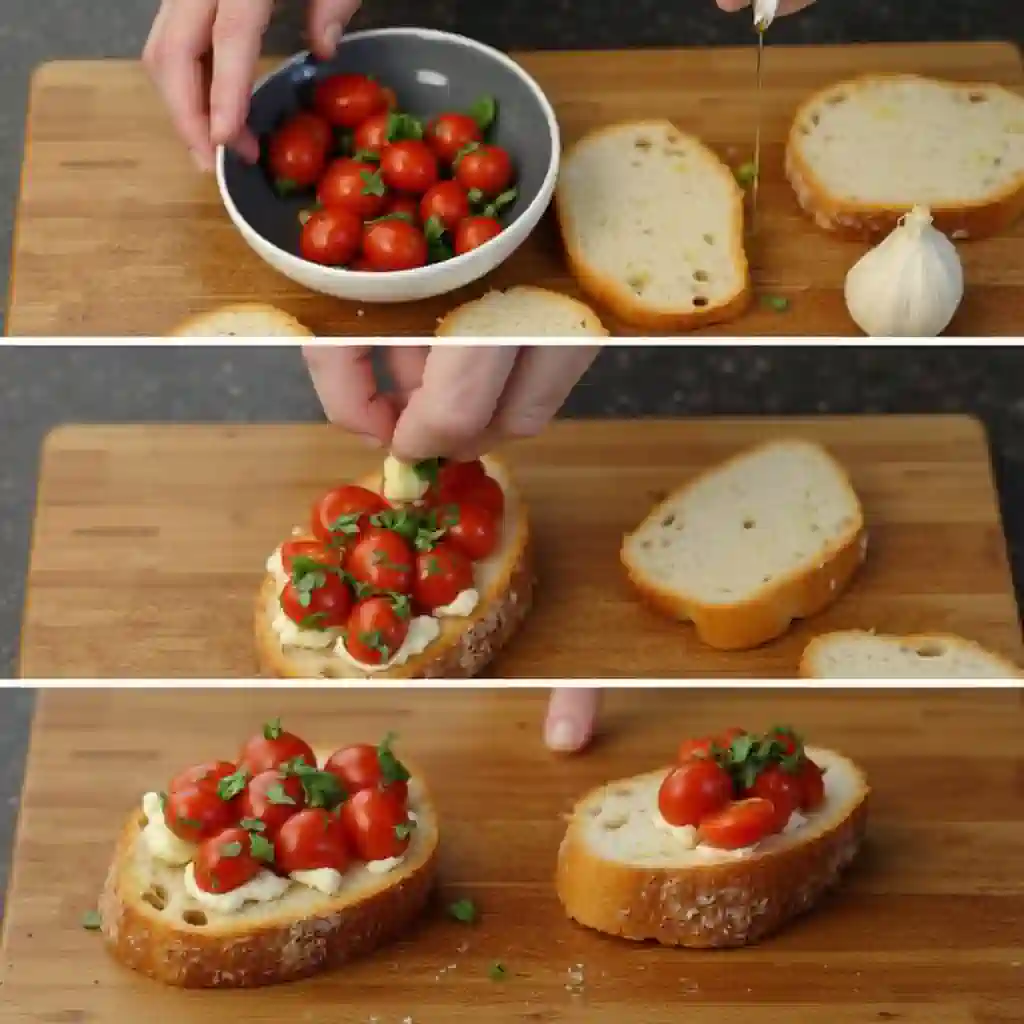Introduction
Bruschetta is more than just an appetizer—it’s a celebration of simple, fresh ingredients that create bold, mouthwatering flavors. This classic Italian dish has been enjoyed for centuries, evolving from a humble snack to a worldwide favorite. Whether you’re a foodie looking to perfect your bruschetta recipe or just someone who loves Mediterranean flavors, this guide has everything you need.
We’ll dive deep into the origins of bruschetta, its essential ingredients, expert preparation techniques, delicious variations, and even its role in Italian culture. Plus, we’ll answer the most commonly asked questions about this beloved dish. Let’s begin!
Table of Contents
What is Bruschetta?
Origins of bruschetta recipe
Bruschetta (pronounced broo-SKEH-tah, not broo-SHET-tah) traces its roots back to ancient Rome. Farmers and olive oil producers would grill bread over an open flame, rub it with garlic, and drizzle it with freshly pressed olive oil—essentially the earliest version of this dish. The name itself comes from the Italian verb bruscare, meaning “to toast” or “to char.”
Historically, bruschetta was a way to test the quality of new olive oil. Over time, Italians began adding toppings like tomatoes, basil, and cheese, turning this simple snack into the flavorful dish we know today.
Traditional vs. Modern Bruschetta
Traditional bruschetta keeps things simple: rustic bread, high-quality olive oil, garlic, and salt. However, modern versions have expanded beyond Italy’s borders, with countless creative toppings such as:
- Tomatoes and basil (the most popular version)
- Mozzarella and prosciutto
- Roasted peppers and ricotta
- Avocado and balsamic glaze
While purists argue that only the original recipe is true bruschetta, food lovers worldwide have embraced new flavors, making this dish a staple at gatherings and restaurants.
Common Misconceptions About Bruschetta
Despite its popularity, bruschetta is often misunderstood. Here are a few common misconceptions:
- It’s not just about the topping – The base of a good bruschetta is the bread, toasted to perfection.
- It’s not a cold dish – While the toppings can be fresh, the bread is always served warm and crisp.
- It’s not the same as crostini – Crostini are smaller, thinner slices, usually made from a baguette, while bruschetta uses larger, rustic bread slices.
The Ingredients of Authentic Bruschetta
Classic Bruschetta Ingredients
The beauty of bruschetta lies in its simplicity. A few fresh, high-quality ingredients make all the difference. Here’s what you need:
- Bread – A rustic loaf like ciabatta or sourdough works best.
- Olive oil – Extra virgin olive oil adds richness and depth.
- Garlic – For that signature bold flavor.
- Tomatoes – Fresh, ripe tomatoes bring sweetness and juiciness.
- Basil – A fragrant herb that enhances the overall taste.
- Salt & Pepper – Essential for seasoning.

Choosing the Right Bread
Bread is the foundation of bruschetta, so picking the right kind is crucial. The best options are:
- Ciabatta – Light and airy with a crisp crust.
- Sourdough – Tangy and firm, perfect for grilling.
- Rustic Italian Bread – A traditional choice with great texture.
The key is a sturdy loaf that holds toppings without getting soggy. Slice it thick enough to stay crispy but not too thick to overpower the toppings.
Best Tomatoes for Bruschetta
Tomatoes are the star of bruschetta, and choosing the right variety makes a huge difference. Some of the best options include:
- Roma tomatoes – Firm and less watery.
- Cherry tomatoes – Sweet and vibrant.
- Heirloom tomatoes – Rich in flavor and color.
Always go for ripe, in-season tomatoes for the best taste.
Essential Herbs and Seasonings
- Fresh basil – Adds a refreshing aroma and mild peppery taste.
- Sea salt & cracked black pepper – Enhances all the flavors.
- Balsamic glaze (optional) – A drizzle adds sweetness and acidity.
Bruschetta Nutrition Facts (Per Serving)
| Nutrient | Amount |
|---|---|
| Calories | 150 kcal |
| Carbohydrates | 18g |
| Protein | 3g |
| Fat | 7g |
| Fiber | 2g |
Now that we’ve covered the best ingredients, let’s move on to preparing bruschetta the right way!
How to Make the Best Bruschetta
Step-by-Step Traditional Recipe
Follow this simple recipe to create the perfect bruschetta.
Ingredients
| Ingredient | Quantity |
|---|---|
| Rustic bread | 6 slices |
| Ripe tomatoes | 2 cups (diced) |
| Fresh basil | ¼ cup (chopped) |
| Garlic cloves | 2 (peeled) |
| Extra virgin olive oil | 3 tbsp |
| Sea salt | To taste |
| Black pepper | To taste |
Instructions
- Prepare the bread – Slice the bread about ½-inch thick. Grill or toast it until golden brown and crisp.
- Rub with garlic – While warm, rub one side of each slice with a peeled garlic clove.
- Prepare the topping – Dice the tomatoes and mix them with chopped basil, olive oil, salt, and pepper. Let it sit for 10 minutes to enhance the flavor.
- Assemble the bruschetta – Spoon the tomato mixture onto each slice. Drizzle with extra olive oil or balsamic glaze.
- Serve immediately – Enjoy while the bread is still crisp!
Secrets for the Perfect Bruschetta

Want next-level bruschetta? Follow these expert tips:
- Use high-quality olive oil – It makes a difference in taste.
- Don’t over-toast the bread – A slight char adds flavor, but too much makes it tough.
- Let the tomato mix sit – This helps the flavors blend beautifully.
Common Mistakes to Avoid
- Using soggy bread – Always toast it well.
- Overloading with toppings – Less is more to keep the bread crisp.
- Skipping garlic – It’s essential for authentic bruschetta!
Serving Suggestions and Pairings
Bruschetta pairs perfectly with:
- Fresh mozzarella or burrata
- Prosciutto or salami
- A crisp white wine like Pinot Grigio
Now that you’ve mastered the art of making bruschetta, let’s explore different variations!
If you’re interested in more delicious recipes, consider checking out their homepage for a variety of culinary inspirations.
Popular Variations of Bruschetta
While the classic tomato and basil bruschetta is a timeless favorite, there are many delicious variations to explore. From rich cheeses to sweet twists, there’s something for everyone!
Classic Tomato and Basil Bruschetta
This is the most well-known version, made with ripe tomatoes, fresh basil, garlic, olive oil, and sea salt on toasted bread. Simple, fresh, and full of Mediterranean flavors, it’s the go-to choice for traditionalists.
Tip: Let the tomato mixture sit for at least 10 minutes before serving—it allows the flavors to blend beautifully!
Cheese and Meat Bruschetta Variations
Want to add extra richness? Try incorporating cheese or cured meats:
- Mozzarella & Basil – A Caprese-style twist with fresh mozzarella slices.
- Goat Cheese & Honey – Creamy and tangy with a touch of sweetness.
- Prosciutto & Arugula – A savory bite with an Italian deli feel.
- Ricotta & Roasted Peppers – A creamy, smoky variation.
Each of these combinations brings a unique depth of flavor, making bruschetta a crowd-pleasing appetizer.
Vegan and Gluten-Free Options
You don’t have to miss out on bruschetta if you have dietary restrictions! Here are some ideas:
- Gluten-Free Bruschetta – Use gluten-free bread or toasted polenta as a base.
- Avocado Bruschetta – Mash avocado with lime and sea salt for a creamy alternative.
- Mushroom & Thyme Bruschetta – Sautéed mushrooms add a deep umami flavor.
Sweet Bruschetta: A Unique Twist
Who says bruschetta has to be savory? Try a sweet version for a fun dessert or brunch option!
- Strawberry & Mascarpone – Creamy and fruity with a drizzle of honey.
- Peach & Ricotta – Sweet and tangy with fresh mint.
- Dark Chocolate & Hazelnuts – Perfect for chocolate lovers.
These variations prove that bruschetta is incredibly versatile, whether you love traditional flavors or want to experiment with something new!
Bruschetta in Italian Cuisine and Culture
Bruschetta isn’t just a dish—it’s a symbol of Italian hospitality and tradition. From humble beginnings to global fame, this appetizer has a special place in Italian cuisine.
Bruschetta’s Role in Italian Traditions
In Italy, bruschetta is often served as an antipasto (appetizer), especially at family gatherings and celebrations. The dish embodies the Italian philosophy of simple, high-quality ingredients, making it a favorite in both home kitchens and restaurants.
It’s also a key part of olive oil tasting events, where freshly toasted bread is drizzled with new-season olive oil to highlight its bold, peppery flavors.
How Bruschetta Differs Across Italy
Like many Italian dishes, bruschetta varies by region:
- Tuscany – Often served with only garlic, olive oil, and salt (known as fettunta).
- Naples – Features bright tomatoes and basil, staying true to the classic recipe.
- Sicily – Includes capers, olives, and anchovies for a bold, briny twist.
Each region puts its own spin on the dish, but the core concept remains the same: toasted bread with flavorful toppings.
How Italians Pronounce Bruschetta
One of the biggest misconceptions is the pronunciation of bruschetta. Many English speakers say “broo-SHET-tah,” but the correct Italian pronunciation is “broo-SKEH-tah.”
It follows standard Italian pronunciation rules, where “sch” is always pronounced as a hard “K” sound. Now, you can confidently order bruschetta like a true Italian!
FAQs About Bruschetta
Curious about bruschetta? Here are answers to some of the most common questions about this classic Italian dish!
What are the ingredients in bruschetta?
Traditional bruschetta is made with simple, fresh ingredients that enhance its flavor and texture. The essential ingredients include:
- Rustic bread – Ciabatta or sourdough works best.
- Garlic – Adds a bold, aromatic touch.
- Extra virgin olive oil – The heart of authentic bruschetta.
- Fresh tomatoes – Juicy, ripe tomatoes bring sweetness and acidity.
- Basil – A fragrant herb that pairs perfectly with tomatoes.
- Sea salt and black pepper – Essential for seasoning.
Some variations include balsamic glaze, mozzarella, prosciutto, or even avocado for a modern twist!
What is the secret to the best bruschetta?
Great bruschetta comes down to quality ingredients and proper preparation. Follow these tips to elevate your dish:
- Use fresh, ripe tomatoes – The juicier, the better!
- Choose high-quality olive oil – It enhances the overall taste.
- Toast the bread correctly – It should be crispy outside but soft inside.
- Let the tomato mixture sit – This allows the flavors to meld beautifully.
- Rub garlic on warm bread – This step adds a deep, savory aroma.
By following these secrets, you’ll make bruschetta that tastes just like it does in Italy!
Do you eat bruschetta hot or cold?
Bruschetta is best served with warm, toasted bread and room-temperature toppings. The contrast between crispy, slightly warm bread and fresh, juicy tomatoes makes it incredibly satisfying.
Avoid serving it completely cold, as the flavors won’t be as vibrant. Similarly, don’t overheat the toppings—they should stay fresh and light!
Conclusion
Bruschetta is a true celebration of simple, fresh ingredients and traditional Italian flavors. Whether you prefer the classic tomato and basil version or enjoy experimenting with new toppings, this dish remains a versatile and delicious appetizer.
By choosing high-quality ingredients, toasting your bread just right, and following authentic preparation tips, you can make the perfect bruschetta at home. Now, it’s time to grab some fresh bread, ripe tomatoes, and a bottle of extra virgin olive oil—and start creating your own masterpiece.
Buon appetito!

